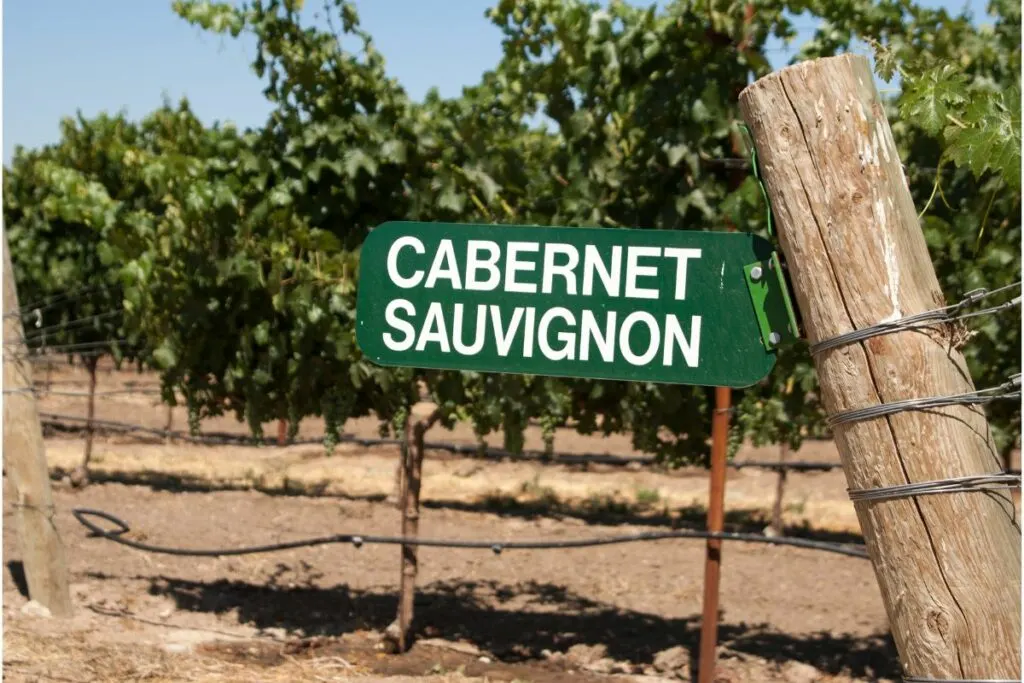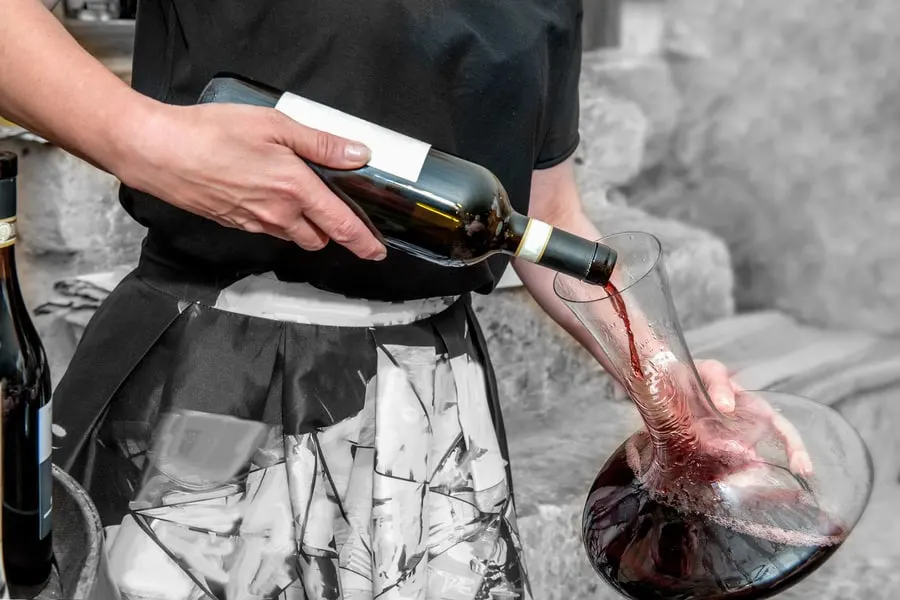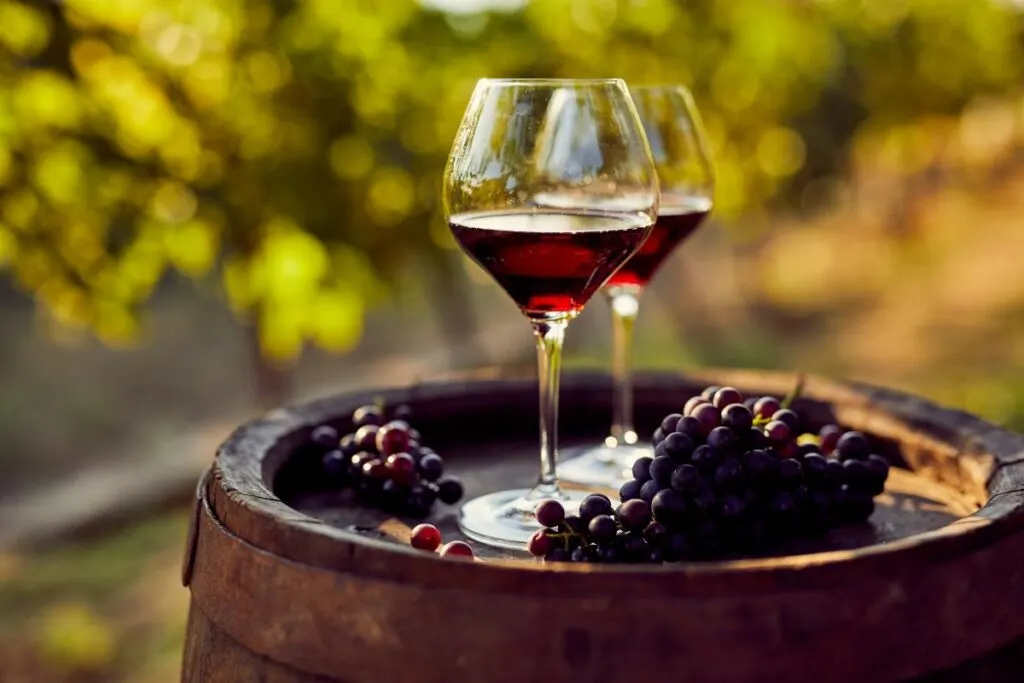As an Amazon Associate, I earn from qualifying purchases with no additional costs for you.
Cabernet Sauvignon is the most widely planted and one of the best-known wines across the globe, and it is especially renowned for its ability to age and mature in the bottle for decades. For anyone getting into serious wine collecting, understanding how to best store Cabernet Sauvignon is important.
Cabernet Sauvignon should be stored around 55° F, in 70% humidity, under steady conditions, in darkness, with the bottle lying flat with labels facing up. Once opened, Cabernet will last up to 7 days if a quality wine stopper is used and you keep the bottle upright in your kitchen refrigerator.
Let’s get back to the basics here. What is Cabernet Sauvignon and what makes it so age-worthy? Cabernet Sauvignon, commonly referred to simply as ‘Cab,’ originated in France, and the wine region of Bordeaux remains the flagship region for high-quality Cab.
Cabernet is a naturally occurring cross between fellow Bordeaux varieties Cabernet Franc and Sauvignon Blanc (hence the name) and is now considered a noble grape in France.
Despite its beginning in the Old World, Cab has made its mark in the New World as well. Napa Valley, California is perhaps the most globally recognized New World spot for Cabernet Sauvignon, but other areas in California, Washington State, Chile, Argentina, and Australia all have significant plantings and production of Cab.
Cabernet Sauvignon is the cornerstone of some of the most famous red blends in the world – left bank Bordeaux First Growths, Opus One, Screaming Eagle, and Insignia out of Napa Valley, just to name a few – and with good reason.
It adds firm tannins and nice structure to the blend, along with dark fruit notes like blackberry and cassis, and often savory characteristics such as bell pepper, menthol, and tobacco.
Cabernet is recognized as one of the most age-worthy red wines in the world. That aforementioned structure along with the intensity of flavors and ability to evolve over time in the bottle all make it an extremely compelling wine to age for years, or even decades.

TIP: If you want to check out the best refrigerator for wine storage, I recommend trying out the Avation (18 bottles) compressor refrigerator with Wi-fi smart app control cooling system. You can find this refrigerator by clicking here (Amazon link).
How to Store Unopened Cabernet
While Cab is one of the most age-worthy wines out there, proper storage will make or break even the more precious bottles.
Cabernet is subject to the same guidelines as all wines when talking about long-term storage. Temperature is undoubtedly the most important factor, followed by humidity, light, and vibrations.
55 degrees F is the ideal storage temperature for both red and white wines. A few degrees one way or the other isn’t a big deal; rather, maintaining a consistent temperature and avoiding swings is essential for guarding the wine.
Humidity along with bottle orientation helps keep the cork from drying out. Humidity should be around 70%, and bottles should always be stored on their sides so that the liquid inside remains in constant contact with the cork.
This prevents the cork from drying out, which can lead to more oxygen getting into the bottle (causing premature aging or even spoilage), as well as wine leaking out. Finally, storing the bottles’ labels side up can be beneficial from an organizational standpoint.
While most wines intended to be age-worthy are in dark bottles, preventing any additional UV exposure is important. A dark spot that stays pretty dim (again, consistency – no flashes of light or sudden changes) will help keep the wine in prime condition.
Finally, a spot free of vibrations and movement will further protect the wine (and your investment). In the short term (a few days to a couple of months), a bottle can be kept on a shelf or in a cabinet, although avoiding heat sources is still something to be mindful of.
An unused corner of a closet works in a pinch, as these spaces are usually dark, free of a lot of movement, and away from heat. A dark basement is also a good option in lieu of more sophisticated equipment, with the natural humidity and lack of sudden changes.
TIP: Read this article for ideas on how to store unopened red wine the right way! Use this checklist for tips and hacks on the dos and don’ts of proper wine storage.
Of course, a wine fridge or larger wine cabinet is a worthwhile investment if your collection holds valuable wines (more on these options in a bit), or a built-in wine cellar if space and finances allow.
If none of these are viable options for you, a professional wine storage facility may be the route to go. Remember, all of these options are ways to protect your investment, whether you plan to sell your collection or enjoy it, bottle by bottle.
Recommendation box: Everything you need to enjoy your wine as much as possible. All recommended products are personally tested and regularly used by experts from this website (Amazon links):
> Ivation Wine Cooler – Energy-efficient wine cooler for 18 bottles with Wi-fi smart app control cooling system.
> Wine Rack – Beautiful, elegant wood rack for up to 7 bottles and the choice of vertical or horizontal storage.
> Durand Wine Opener – Classic vintage wine opener (we like all these classic staff).
> YouYah Iceberg Wine Decanter – The most beautiful and handy wine decanter we personally use.
> Bormioli Rocco Wine Glasses – A set of eight elegant and traditional wine glasses made in Italy.
> Vintorio Wine Aerator – Simple but really useful wine aerator for a reasonable price.
> The Original Vacu Vin Wine Saver – The best wine saver on the market in a package with two vacuum stoppers and two wine servers.
And if you want to become a true connoisseur of wine, we recommend reading the book Wine Folly: The Essential Guide to Wine (Amazon link), where you will find all the information you need about winemaking, wine varieties, flavors, and much more.
Which Cabernet gets Aged & which ones should you drink right away?
There are a lot of phenomenal super-premium Cabernets produced around the world. That said, the vast majority of Cab (and wine in general) on the shelf is meant for early drinking – studies show that most Americans go to the store to buy a bottle of wine to enjoy with dinner that evening, not to purchase investment-worthy bottles to store for years or decades before opening.
Wine producers have responded to that by offering inexpensive, easy-drinking wines for immediate consumption. In fact, it is estimated that only about 1% of the wine produced around the world is intended for aging.
So how do you know if you have an age-worthy wine in the first place? Price can be an indicator (typically more expensive bottles are of higher quality, but this is not always the case).
A bottle with a cork and dark glass are also signs that this wine is meant to be stored. If possible, buy a few bottles of the same wine and open them periodically to see how the wine is evolving. When in doubt, ask the producer directly, or consult with a trusted wine professional.
How Long Should Cabernet Age?

A high-quality Cabernet Sauvignon can age for years and even decades. How long it will age before it reaches peak drinkability depends on the producer, the vintage conditions, the quality of the wine, and how it is stored (proper storage like discussed above can extend a wine’s lifetime by years).
The science of what chemical reactions occur that cause wine to evolve in the bottle is yet to be fully explained; the process remains kind of mystical.
However, we know that tannins and proteins interact over time (this is the sediment at the bottom of an aged bottle of wine), so a wine with firm tannins is a good starting place.
High-quality Cabernet Sauvignon often has rather astringent tannins upon release. The grape itself provides a heavy dose of tannin, and extended aging in oak further exemplifies that.
These wines often seem tight while young, but the aging process allows them to smooth out and open up. You also want a wine with deep, concentrated flavors so that intensity doesn’t fade too much during aging. This is one reason why vintage (the conditions of the year the grapes were harvested) is so important.
Super rainy years, for example, can dilute the grapes and result in thin, less concentrated wines. Finally, balance is key to age-worthiness. The fruit, tannin, acidity, and alcohol should be in sync with one another – one component shouldn’t overwhelm the others.
Large-format bottles (magnum and larger) are even more conducive to long term aging (the ratio of wine to oxygen is lower, so these mature more steadily and slowly), so if you are collecting a favorite producer or region, seeking out large format bottles may be something to look into.
When deciding when to finally pop the cork on a special bottle, my advice is always to check directly with the producer, if that is an option.
TIP: Read this article to discover how to store wine using a cork. Do you know why a wine bottle shape matters? We compare 7 different bottles in this article.
Many high-quality wineries that make age-worthy wines do their own trials and testing to advise customers on peak drinkability. For example, Penfolds out of Australia publishes The Rewards of Patience every five years or so, evaluating the drinkability of decades worth of vintages.
If the exact producer isn’t available, many wine publications regularly publish vintage charts by variety and region to help guide consumers on when to open their most prized wines.
Finally, a note on securing collectible bottles. Often, instead of buying a bottle and storing it for years, collectors seek out older vintages of already aged wines.
This route has some merit (instant gratification, for one) but a word of caution – be sure to seek out reputable auction houses, collectors, and resellers who can provide the providence of the bottle and trace its owners and how it has been stored over the years.
Don’t waste your money on a coveted bottle only to find out that it was stored improperly and the wine has gone off.
Cabernet Storage: Refrigeration & Room Temperature
If using a wine fridge or cabinet, the wine should be stored around 55 degrees F (as I always say, picture a gloomy, chilly wine cave under the famous chateaux of Bordeaux – wine storage should try to emulate that environment). It is important to keep Cab at these temperatures for long-term storage.
For bottles you’ll be opening sooner, it is less imperative. Cabernet can be stored on a shelf or in a wine bar at room temperature for days or a couple of weeks without harming it.
Below I’ll discuss serving the wine; the ideal serving temperature for Cabernet is usually around 60-65 degrees, so room temperature may be a little warm (of course, it depends on how warm you keep your home).
Above 70 degrees F, the alcohol and any residual sugar in the wine can take over, making the wine seem less nuanced on the palate. Stick the bottle in your kitchen refrigerator for 10-15 minutes to bring it down to serving temperature.
Wine Refrigerators & Cabernet Storage
Given the conditions discussed above, a wine fridge can be ideal for storing Cabernet, especially a higher-end model that is going to include stable temperature and humidity control.
These fridges tend to have a small footprint so they can fit into most spaces (on the flip side, this does limit their bottle capacity). A wine cabinet can be a more robust option for someone with an expanding wine collection.
Cabinets are larger (often able to store several hundred bottles) and more powerful, so they can be more reliable when it comes to keeping a stable, consistent temperature (and therefore protecting the precious wine within).
Both fridges and cabinets often have additional UV protection built-in, and many offer shock absorptions to dimmish vibrations.
TIP: Is there a difference between a wine cooler and a wine refrigerator? Read this article to find out! This article features the best 55 refrigerators with costs. You are sure to find the perfect wine refrigerator for your needs.
Both fridges and cabinets range from a couple of hundred dollars to a few thousand, depending on the size and the bells and whistles of each model. When thinking about purchasing one of these options, consider how much you spend on wine annually and how much of that is a fine wine that you’ll be storing for at least a few years.
If the value of those bottles is equal to or beyond the cost of the fridge, then it is a worthwhile expense for protecting your investment.
How to Store Opened Cabernet

An airtight seal is the most important factor when storing an open bottle. After that, keeping the bottle in your refrigerator may help it stay fresher a little longer. At the very least, keep the bottle away from heat sources like the stovetop.
A Coravin system is the best investment you can make if you’re regularly opening and not immediately finishing valuable bottles.
These nifty devices allow you to pour wine – a sip, a sample, a full glass – and replace the displaced volume with inert gas. This gas protects the rest of the wine in the bottle and blocks additional oxygen from interacting with it.
These systems range from a couple of hundred dollars and up, but if you’re a regular wine drinker drinking bottles for $30 or more, they pay for themselves.
Coravin also offers different needles for their devices, including the Vintage Needle that is designed for older, more fragile corks like those in aged Cabernet.
TIP: Most wines go bad once you pop the cork within a day or so. But a Coravin Wine Preservation system (available for a great price on Amazon) can extend the life of your opened wine for weeks or even months. It is awesome. You should check it out to see if it fits your lifestyle.
If a Coravin is not available, refer to the tips above – the more airtight the seal, the longer the wine will last (this keeps oxygen at bay).
Avoid vacuum seal or pump systems – these tend to pull out the aromatics of the wine as they’re pumping out the air, diminishing the enjoyment of whatever liquid remains in the bottle.
TIP: Are you interested in buying a wine stopper? We’ve personally tried and recommend buying one of these wine stoppers (Amazon links):
- The Original Vacu Vin Wine Saver: Our top choice. Very easy-to-use wine stopper/saver. You can enjoy a glass of fresh wine whenever you want without worrying about wasting any.
- EZBASICS Wine Saver: Great alternative to Original Vacu Vin Saver. This wine stopper keeps the flavor of wine for up to one week.
- Champagne Stopper by MiTBA: Wine stoppers for sparkling wines are different. This wine stopper seals your bottle and increases the pressure so your beverage’s bubbles won’t go to waste.
How Long Cabernet Lasts Once Opened
To a certain extent, this is a matter of personal preference and the sensitivity of your palate, along with the style and age of the wine in question.
I tend to be really picky and only enjoy a wine up to about 24 hours after opening, while I know fellow wine professionals will keep a bottle for a few days or a week.
Drink what tastes good to you! Younger wines may benefit from being open for a while, and as oxygen interacts with the wine, they may continue to evolve up to 24 hours after originally opening. A fun experiment is to open a bottle and taste it every hour or so, keeping notes of how the fruit, acidity, and tannin profiles change.
Eventually, any wine will reach a point where oxygen becomes the enemy and the flavors turn sour. Typically, this happens sooner for an older wine, while a younger bottle can hang in a bit longer.
How to Know if Cabernet has Gone Bad

Wine can go off in the bottle as well as after opening. The most common reason for aged wine being off is either the wine was faulty, to begin with (see below), or has aged too long.
Aged Cabernet will change in flavor profile, structure, and color. The primary fresh fruit flavors will evolve into tertiary notes of dried fruits, potpourri, and tobacco.
Meanwhile, the tannins will become more integrated and the wine becomes smoother, and the color changes from bright ruby to more garnet.
The aging process adds complexity to the wine, and for many aficionados, this makes the experience more enjoyable. There is a point however when the wine reaches its peak and begins a downward trend.
The flavors drop out and the wine loses intensity of both aroma and flavor. Picture a bell curve – the wine will slowly develop up to one side of the curve until it reaches the peak, and then decline over time. Beyond wine that is “over the hill” there are a few common flaws to look out for when opening a bottle.
Corked wine is the most common of these, especially among bottles with some age to them. Corked wine happens with chemical compounds found naturally in cork are exposed to certain sterilizers, like chlorine.
The result is musty, wet newspaper aromas and a lack of fruit flavors. While the most common, this only occurs in about 3% of bottles globally each year, so don’t let the possibility discourage you!
TIP: Why does unopened wine go bad? Is there a simple explanation? Read this article to find out. This article discusses the key factors why wine can ferment in a bottle. Don’t miss it!
Oxidation and modernization are two other flaws to be on the lookout for. Oxidation can occur both in the bottle (a faulty cork with no tight air seal would be to blame here) or after the wine is opened, as described below. The wine turns brick-ish in color and suffers from loss of flavor.
Temperature spikes and exposure to heat sources can cause the wine to become cooked or ‘maderized.’ The fruit becomes jammy, stewed, or resinated, but in a harsh, unpleasant, sour way.
Opened wine also changes as it interacted with oxygen. This may be a positive thing for several hours (maybe even days) after being opened, but eventually, oxygen becomes the enemy and the wine goes bad.
You’ll notice a sour taste; the fruit becomes less upfront and the acidity morphs from refreshing to unpleasantly tangy. At this point, there’s not much you can do to save whatever is left in the bottle.
Follow the tips above to extend the lifetime of the opened bottle, and when in doubt, invite over some fellow wine connoisseurs and enjoy the whole thing to ensure you don’t waste a drop!
How to Serve Cabernet/Ideal Serving Temperature

Most aged wines, including Cabernet, will benefit from decanting prior to serving. Decanting helps aerate the wine, waking up the aromas and flavor that have been silent in the bottle for so long.
It also helps separate the wine from the sediment that naturally occurs during the aging process – tries to keep the bottle horizontal during the process, from removing it from storage to pouring into the decanter, as the sediment will have collected in the bottle and this helps prevent it from getting mixed back into the wine.
Ideally, big red wines like Cabernet should be served just above cellar temperature (which, as mentioned, is around 55 degrees F).
60-65 degrees F is considered best for Cabernet. Pull the bottle out of the wine fridge, decant, and then let it sit for a few minutes prior to serving to bring it up to the perfect temperature.
It is usually best to let a freshly opened or decanted wine breathe for about 30 minutes anyway, so it all works out. Tools beyond the traditional corkscrew may be needed to open the bottle, depending on its age. Even if it was properly stored on its side, the corks become fragile over time.
TIP: If you are interested in buying a wine decanter, I recommend purchasing these two top-quality decanters:
- USBOQO Wine Decanter (check it out on Amazon & read customer reviews)
- Iceberg Wine Decanter (check it out on Amazon & read customer reviews)
A water’s corkscrew may be too rough, causing the cork to crumble (in this case, decant through a fine sieve and you’ll be fine).
An AH-So (sometimes also called a cork extractor or butler’s friend) is an inexpensive handy little tool that goes into the bottle between the cork and the neck, rather than through the cork, and is a gentler approach.
Aged Cabernet Sauvignon can be one of the most rewarding and ethereal drinking experiences out there. With patience, and by following these guidelines, it is not as unattainable as you may think.
TIP: Check out this page for a complete list of wine products and accessories I love. You’ll find my recommendations for wine refrigerators, decanters, and aerators and the best place to buy wine online. Click here to see the complete listing.
